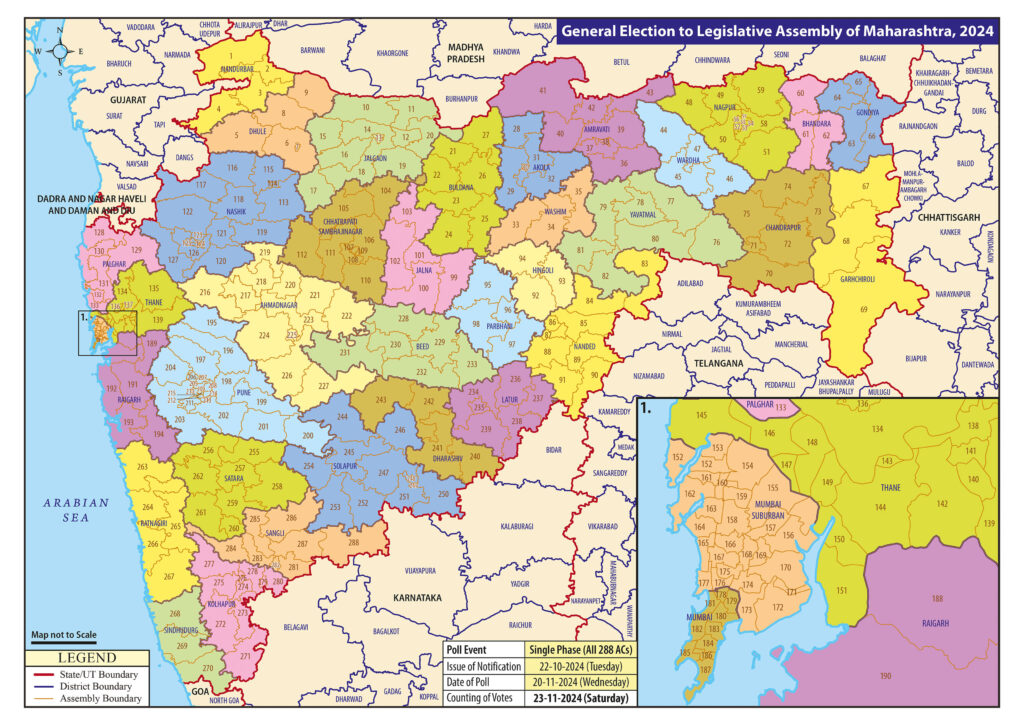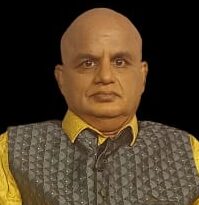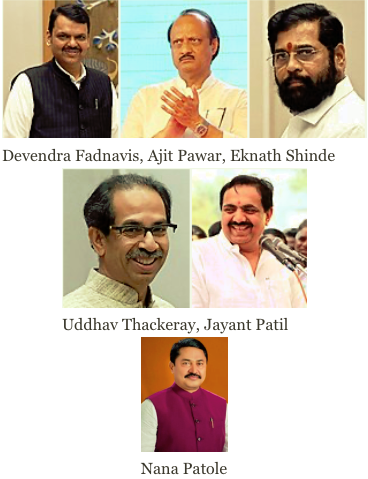
Image source: ECI
Mumbai: The defeat of the Congress Party in Haryana has sounded alarm bells for the Maha Vikas Aghadi (MVA) which comprises the Congress Party, the Shiv Sena (Uddhav Balasaheb Thackeray), and the Nationalist Congress Party (NCP) in Maharashtra.
While NCP supremo Sharad Pawar and others in the MVA claim they will secure over 200 seats, many question whether the trend seen in Haryana will be replicated in Maharashtra. In Maharashtra, the Bharatiya Janata Party (BJP)-led Mahayuti (The National Democratic Alliance (NDA) in Maharashtra is known locally as Mahayuti) was previously halted at just 17 seats in the 2024 Lok Sabha elections. Out of the 48 Lok Sabha seats in the State, the MVA won 30 seats, and after one independent candidate pledged support to the Congress, its number went up to 31.
However, this battle will not be as easy for the MVA as it appears on paper. The MVA leaders should not fall into the illusion that Lok Sabha equations will translate directly into the Assembly elections.
The Haryana results are a wake-up call for the MVA, which must avoid the delusion of guaranteed victory or claims of becoming the chief minister.
Maharashtra’s political landscape is fragmented among six parties, each concentrated in specific regions. The divided NCP (Sharad Pawar faction and Ajit Pawar faction) has strength only in Western Maharashtra, and the split Shiv Sena (Uddhav Thackeray faction and Eknath Shinde faction) is strong in Mumbai and Konkan. Previously, the BJP played a significant role in the Sena’s successes in other regions of the State.
Concerning the Congress Party, which is headed in Maharashtra by a former Speaker of the State Assembly and a former Member of Parliament from the Bhandara-Gondia Parliamentary Constituency of Vidarbha, Nana Patole, its strength lies in Vidarbha, Marathwada, Mumbai, and Western Maharashtra, but it is weak in the Konkan region.
In Haryana, the Aam Aadmi Party supremo Arvind Kejriwal leveraged his candidates to divert votes from the Congress Party, ultimately aiding the BJP through vote splitting. Congress faced significant losses, with candidates losing by narrow margins in at least 15 constituencies, while the BJP candidates won with minimal leads.
In Maharashtra, parties like Vanchit Bahujan Aghadi (VBA), The All India Majlis-e-Ittehadul Muslimeen (AIMIM), and the Maharashtra Navnirman Sena (MNS) also contribute to vote splitting.
Although the influence of these parties was less noticeable in the Lok Sabha elections, the current political environment does not favour the Mahayuti. From 2019 to 2024, three governments have operated in Maharashtra, each having Ajit Pawar as deputy chief minister, but with different chief ministers. The power shifts have been primarily for the chief minister’s post. The longstanding Sena-BJP alliance fractured when BJP refused to concede the chief ministership to Uddhav Thackeray for the full term, resulting in a division of the remaining tenure between him and the present Maharashtra Chief Minister Eknath Shinde.
The next government in 2024 will likely depend on who claims the chief minister’s position. After the Congress Party’s defeat in Haryana, the tone of Shiv Sena’s mouthpiece Saamana has changed, urging the Congress Party to introspect. This situation seems a ploy to leverage the Congress Party’s predicament for further political gain.
Uddhav Thackeray’s demand for a declared chief minister candidate from the MVA appears to be aimed at securing his own political position. However, his limited presence in office during his tenure as the chief minister raises doubts among the Congress Party and the NCP about endorsing him as their chief ministerial candidate.
Historically, since 1995, the chief minister’s selection has followed a formula based on party strength. However, Thackeray now wishes to overturn this tradition, insisting on his candidacy while pushing for a formal declaration of a chief ministerial candidate from the MVA.
The confidence among the Congress Party leaders post-Haryana, believing they can win 80 to 85 seats in Maharashtra and become the largest party in the MVA, makes them resistant to declaring Thackeray for the chief minister’s position. If the NCP also secures around 60 to 70 seats, it could lead to a scenario where both parties might govern without Shiv Sena.
Given Sharad Pawar’s age, he might consider merging his party with the Congress Party to facilitate his daughter Supriya’s rise to the chief ministership. Just as the chief ministership altered the political dynamics in 2019, a similar shift could occur again.
The possibility of a leader akin to Nitish Kumar emerging in Maharashtra’s shifting political landscape cannot be discounted. Even Uddhav Thackeray could end up transforming into a Nitish Kumar figure if it means securing the chief minister’s post.
For now, this remains the political scenario in Maharashtra, which goes to poll on November 20, 2024, to elect the 288 Members of the 15th Maharashtra Legislative Assembly.
*Senior journalist








In any given scenario BJP will be the looser. Maharashtra is not Nitish Kumar’s Bihar, where Uddhav Thackeray will make a U-Turn just to occupy CM’s chair. He has to give back to BJP in the November 20 polls for engineering the split of Shiv Sena, founded by his father and graced by his grandfather Prabhodhsmkar Thackeray. There is no need for Congress-NCP in case if they get majority on their own to dump Uddhav. The Sena Chief is a sober and cultured leader, who believes in keeping his words. Many times he has said his fight is with Modi-Fadnavis led BJP for taking away his MLAs and betraying Sena, with whom they had whole heartedly supported while no one wanted to ally with the saffron party BJP.